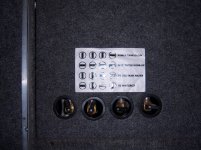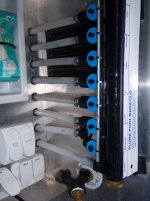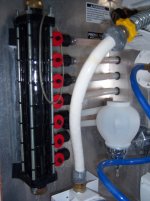G_Hage
Active Member
An instruction manual explaining how this works would have been helpful! Hehehe
Based on the attached photo showing the four valves in my basement, there is a contradiction in the actual valve orientation (on/off) and the instruction sticker. I'm on city water hooked to the city connect on the fiver. So based on the current valve pattern, I should be drawing from the fresh water tank, not the city supply. At our walk-thru the dealer told us we were currently setup for city water use.
According to this photo, I should have run out of water by now as the tank should be empty. Yet it shows 3/4 full on the probes. So I ask, where the heck is our water coming from?
Also, is it normal for there to be extra water lines that are not connected to the valve manifolds in the wet compartment on the Mount Rushmore?
Sorry these Newbies are so RV stupid!
Based on the attached photo showing the four valves in my basement, there is a contradiction in the actual valve orientation (on/off) and the instruction sticker. I'm on city water hooked to the city connect on the fiver. So based on the current valve pattern, I should be drawing from the fresh water tank, not the city supply. At our walk-thru the dealer told us we were currently setup for city water use.
According to this photo, I should have run out of water by now as the tank should be empty. Yet it shows 3/4 full on the probes. So I ask, where the heck is our water coming from?
Also, is it normal for there to be extra water lines that are not connected to the valve manifolds in the wet compartment on the Mount Rushmore?
Sorry these Newbies are so RV stupid!




